Pulmonary Airway Narrowing
Pulmonary airway narrowing refers to the reduction in airway diameter, which impedes airflow and increases resistance within the bronchial tree. This condition is commonly associated with diseases such as asthma, chronic obstructive pulmonary disease, bronchiectasis, and bronchiolitis, where inflammation, mucus accumulation, or structural remodeling contributes to obstruction. Clinically, patients may experience wheezing, coughing, chest tightness, and difficulty breathing, particularly during physical exertion or acute flare-ups. Recurrent or severe narrowing can lead to ventilation-perfusion mismatch, impaired gas exchange, and increased susceptibility to respiratory infections. Diagnosis relies on a combination of clinical evaluation, imaging, and functional testing. Spirometry is the cornerstone for quantifying airflow limitation, highlighting parameters such as forced expiratory volume in one second (FEV1) and FEV1/FVC ratio. High-resolution computed tomography can reveal structural changes such as airway wall thickening, luminal narrowing, and mucus plugging, while bronchoscopy may provide direct visualization and enable therapeutic interventions. Management strategies target both the underlying cause and symptomatic relief. Pharmacologic therapy includes bronchodilators, corticosteroids, and biologics tailored to the specific disease mechanism. Pulmonary rehabilitation, airway clearance techniques, and patient education on inhaler use further enhance treatment efficacy. In selected cases, interventional procedures like bronchial thermoplasty or stent placement may be employed to mechanically improve airway caliber. By combining precise diagnostics, individualized therapy, and supportive measures, management of pulmonary airway narrowing aims to reduce symptom burden, improve airflow, and enhance daily functional capacity.

Saurabh Chattopadhyay
University of Kentucky College of Medicine, United States
Ranjan Ramasamy
ID-FISH Technology, United States
Sergey Suchkov
N.D. Zelinskii Institute for Organic Chemistry of the Russian Academy of Sciences & InMedStar, Russian Federation
Yong Xiao Wang
Albany Medical College, United States
Ranjan Ramasamy
ID-FISH Technology, United States
Sergey Suchkov
N.D. Zelinskii Institute for Organic Chemistry of the Russian Academy of Sciences & InMedStar, Russian Federation



Title : Novel signaling mechanisms and innovative therapeutic strategies of pulmonary hypertension
Yong Xiao Wang, Albany Medical College, United States
Title : Changing population immunity to COVID-19 in the context of infection, vaccination and emerging SARS-CoV-2 variants
Ranjan Ramasamy, ID-FISH Technology, United States
Title : Susceptibility to SARS-CoV-2 infection and nasal air conditioning ability
Ranjan Ramasamy, ID-FISH Technology, United States
Title : Comparative evaluation of DECAF and BAP 65 scores in predicting outcomes of COPD exacerbations among in patients at Vicente Sotto Memorial Medical Center
Allanys Joy Q Pino, Vicente Sotto Memorial Medical Center, Philippines
Title :
Saurabh Chattopadhyay, University of Kentucky College of Medicine, United States
Title : Personalized and precision Medicine (PPM) as a unique healthcare model through biodesign driven and inspired biotech, translational applications and pulmonology related marketing to secure the human healthcare, wellness and biosafety
Sergey Suchkov, N.D. Zelinskii Institute for Organic Chemistry of the Russian Academy of Sciences & InMedStar, Russian Federation